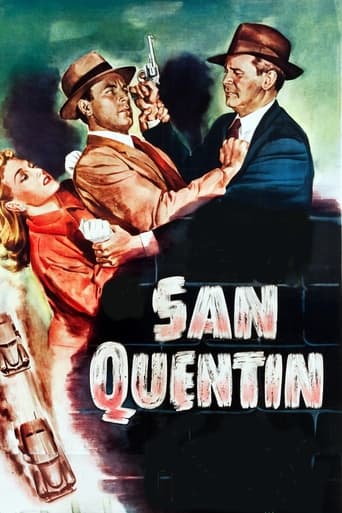dougdoepke
Thoroughly routine cops and robbers, whose only distinction may be Raymond Burr's first screen appearance. The first part is a not very convincing look at reformed convicts who passed through the prison's controversial reform program. It's a worthy topic, but spread on pretty thick. The movie's main part is straight cops and robbers, with reformed convict Tierney trying to nab ruthless MacLane who's abused the program and given it a bad name.Tierney was always more of a presence than an actor. Here his role tends to fade him into the background, overshadowed by the always energized MacLane who ends up stealing the show. Surprisingly, the staging is not noir though the film comes from noir's Mecca, RKO. Instead, prolific director Douglas films in pretty straightforward style, doing little to heighten either suspense or atmosphere. Unfortunately, the result looks like just another studio assignment for him. Fortunately, the movie has two real feminine eye-catchers, the blonde Carr and the brunette Forman. Both are real additions to the rather lackluster visuals. All in all, the movie's not a good vehicle for Tierney's odd appeal. Nor is it compelling cops and robbers. While Burr is more the fall guy than the menacing heavy he could be.
kapelusznik18
***SPOILERS*** Standered prison escape movie with returning GI and former prisoner, in the US not Germany or Japan, Sgt. Jim Roland, Lawrence Tierney, getting involved in a prison brake that he had nothing to do with. It was the hardened hoodlum Nick Taylor, Barton McLane,who used the very liberal San Quentin prison welfare system to fool Warden Kelly, Harry Shannon, into having him get out of the big-house to make a speech in San Francisco about how he's been rehabilitated and turned into a productive citizen by it.Now on the loose and back to his old habits of murder & robbery Taylor seeks out a friend of his Jeff Torrance, Raymond Burr, to get him safe passage out of the country with both money a hot car and a place to cool off while the heat, police, is on him. It's Roland and his pal fellow rehabilitated convict Broadway Johnson, Joe Devlin, who do all the leg work to track Taylor and his partner in crime Steve Marlowe,Tony Barrett, down and bring them to justice before they kill and rob again.***SPOILERS*** Trying to hide out at this deserted duck hunting gun club in the country Taylor is quickly found out by Noland, by breaking a number of arms & legs, in where he's staying and that leads to a bloody shootout between the two at the end of the movie. Taylor who had all the guns and ammunition he needed to hold off Noland ended up being outmaneuvered by him when both men, being extremely poor shots, ran out of bullets with the much more adept, in fisticuffs, Roland putting Taylor, with a couple of lefts & right, to sleep. With the very badly beaten Taylor now back behind bars Roland can concentrate on the girl he left behind Betty Richardson, Marian Carr, for his future plans. P.S "San Quentin" was Raymond Burr of TV's Perry Mason fame film debut.
bmacv
Curiously, San Quentin is not really a Big House movie, since most of it takes place outside prison walls. But the plot is rooted in an earnest concern for the humane rehabilitation of inmates that calls to mind Eleanor Roosevelt. It has the markings of a message movie, but luckily the message, for the most part, gets lost in the action. San Quentin's warden, eager to generate favorable publicity for his inmates' welfare league (through which prisoners police one another to discourage recidivism), accepts an invitation to a press conference in San Francisco and brings along (he thinks) two of his successes. But he gambled wrong on Barton MacLane, who engineers a car-hijacking en route and leaves the warden for dead. Set a thief to catch a thief, the old saying goes. Authorities contact Lawrence Tierney, an ex-con who, after discharge, served honorably in the War, to hunt down his old nemesis MacLane. With sidekick Joe Devil, he starts off in pursuit, handicapped by the strictures his status as parolee impose on him. The movie thus comes down to a cat-and-mouse game, with not much more elaboration than a romantic angle (in the person of Betty Richards) to sweeten up the plot. San Quentin marks Raymond Burr's first appearance in film noir, of which he would become such an irreplaceable fixture. Over the course of the cycle, his weight shot up and down as capriciously as post-war hemlines. On the portly side of average, he would balloon over the next few years, then slim down before his defection to television as Perry Mason. The part he plays here – as a freeside crony of MacLane's – isn't especially distinctive; his menace would grow with his girth.
rsyung
This movie had too much footage devoted to p.r. for the prison system to be a worthwhile noir. Of only marginal interest for Lawrence Tierney fans. The first red-flag that this movie was not going to be what I had hoped for: there is an awkward prologue spoken by the real-life warden of Sing Sing, who seems to be reading enormous cue cards, judging from his eyes sweeping back and forth before the camera. Perhaps he was too vain to wear his eyeglasses.


